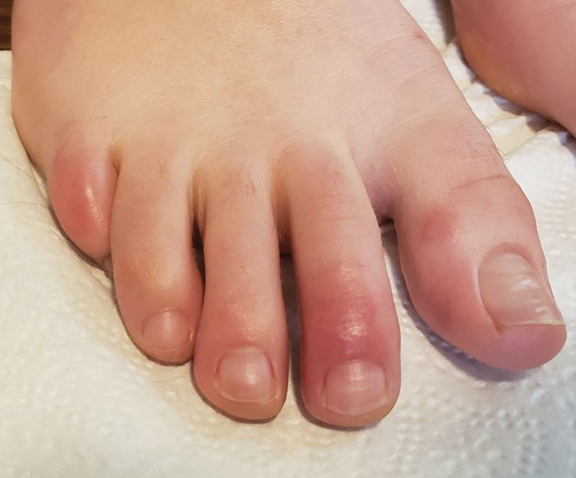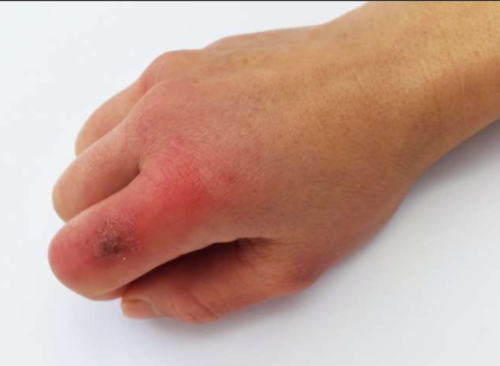With Patrick E. McCleskey, MD

In a recently published article, Dr. McCleskey and colleagues reported findings from an epidemiologic analysis that investigated the incidence of chilblains before and during the COVID-19 pandemic.1
“Certainly, cases of chilblains developing after COVID-19 have been reported, and this temporal association suggests that the inflammatory dermatosis can occur secondary to the viral infection. However, the results of our retrospective cohort study designed to explore the association between the two conditions indicate that chilblains remain idiopathic until proven otherwise,” said Patrick E. McCleskey, MD, Department of Dermatology, Kaiser Permanente Oakland Medical Center, Oakland, California.


Chilblains cases were identified among members of the Kaiser Permanente Northern California system health plan. The review found 780 cases of chilblains diagnosed during the pandemic between April 1, to November 30, 2020, and 539 cases with a chilblains diagnosis made during the prepandemic period that included the same calendar days for the years 2016 to 2019.
Consistent with previous reports indicating a rise in chilblains cases during the pandemic, the annual incidence of chilblains was five-fold higher in the pandemic versus the prepandemic period (28.6 vs. 5.2 per 100,000 person years). However, considering the subgroup of patients with chilblains during the pandemic who underwent PCR testing for COVID-19 (n = 456), only 17 (3.7%) tested positive for the SARS-CoV-2 virus and only 9 (2.0%) had a positive COVID-19 test within the 6 weeks before they were diagnosed with chilblains.
Furthermore, Spearman rank correlation coefficient analyses performed to compare the number of cases of COVID-19 in a particular month and chilblains in the following month for 23 geographic locations showed only a very weak geographic and temporal association.
“If COVID-19 had been causing the cases of chilblains, the two conditions should have occurred in the same geographic locations at the same time,” said Dr. McCleskey.
Accounting for the increase in incidence
In agreement with authors of previously published papers reporting a rise in cases of chilblains during the COVID-19 pandemic, Dr. McCleskey and colleagues believe that the phenomenon is largely explained by changes in behavior that occurred during the pandemic rather than an etiologic relationship between COVID-19 and chilblains.
“People are staying home more during the pandemic and going without shoes,” he said.
Looking beyond the COVID-chilblains association
Due to a lack of access to reliable antibody testing for the SARS-CoV-2 virus during the early pandemic period, only about 60% of the patients with chilblains underwent PCR testing.
“Perhaps improved testing methods to detect past exposure to the virus would result in the identification of more cases of chilblains secondary to COVID-19. Still, we believe further study to investigate a potential relationship is not warranted,” said Dr. McCleskey.
“Other skin manifestations of COVID-19 that are found in severe cases, such as acral ischemia, necrosis, and microthrombi, are potentially much more important to study,” he noted. “Fortunately, these serious problems develop in fewer patients.”
The analyses of demographics of the patients included in the study both characterized differences between patients who developed chilblains before and during the pandemic and described the features of patients with chilblains who tested positive for COVID-19. Data from the latter analysis showed that the incidence of COVID-19 among Latin patients was three-fold higher than among Asian Americans or Whites and double that seen among African Americans.
“Epidemiological studies like ours provide the opportunity to find disparities in our populations that require additional outreach and public health efforts in the broader context of this pandemic,” Dr. McCleskey said.
By Cheryl Gutttman
REFERENCE:
1. McCleskey PE, Zimmerman B, Lieberman A, et al. Epidemiologic analysis of chilblains cohorts before and during the COVID-19 pandemic. JAMA Dermatol. 2021 Jun 23:e212120. doi:10.1001/jamadermatol.2021.2120. Epub ahead of print.
DISCLOSURES:
No relevant disclosures were reported.

